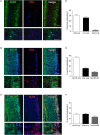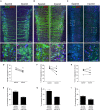Axonal Injury Induces ATF3 in Specific Populations of Sacral Preganglionic Neurons in Male Rats
- PMID: 30405344
- PMCID: PMC6207596
- DOI: 10.3389/fnins.2018.00766
Axonal Injury Induces ATF3 in Specific Populations of Sacral Preganglionic Neurons in Male Rats
Abstract
Compared to other neurons of the central nervous system, autonomic preganglionic neurons are unusual because most of their axon lies in the periphery. These axons are vulnerable to injury during surgical procedures, yet in comparison to peripheral neurons and somatic motor neurons, the impact of injury on preganglionic neurons is poorly understood. Here, we have investigated the impact of axotomy on sacral preganglionic neurons, a functionally diverse group of neurons required for micturition, defecation, and sexual function. We have previously observed that after axotomy, the injury-related transcription factor activating transcription factor-3 (ATF3) is upregulated in only half of these neurons (Peddie and Keast, 2011: PMID: 21283532). In the current study, we have investigated if this response is constrained to particular subclasses of preganglionic neurons that have specific functions or signaling properties. Seven days after unilateral pelvic nerve transection, we quantified sacral preganglionic neurons expressing ATF3, many but not all of which co-expressed c-Jun. This response was independent of soma size. Subclasses of sacral preganglionic neurons expressed combinations of somatostatin, calbindin, and neurokinin-1 receptor, each of which showed a similar response to injury. We also found that in contrast to thoracolumbar preganglionic neurons, the heat shock protein-25 (Hsp25) was not detected in naive sacral preganglionic neurons but was upregulated in many of these neurons after axotomy; the majority of these Hsp25 neurons expressed ATF3. Together, these studies reveal the molecular complexity of sacral preganglionic neurons and their responses to injury. The simultaneous upregulation of Hsp25 and ATF3 may indicate a distinct mechanism of regenerative capacity after injury.
Keywords: axon regeneration; axotomy; intermediolateral nucleus; parasympathetic; preganglionic neurons; spinal nerve injury.
Figures




Similar articles
-
Pelvic Nerve Injury Causes a Rapid Decrease in Expression of Choline Acetyltransferase and Upregulation of c-Jun and ATF-3 in a Distinct Population of Sacral Preganglionic Neurons.Front Neurosci. 2011 Jan 25;5:6. doi: 10.3389/fnins.2011.00006. eCollection 2011. Front Neurosci. 2011. PMID: 21283532 Free PMC article.
-
Deafferentation and axotomy each cause neurturin-independent upregulation of c-Jun in rodent pelvic ganglia.Exp Neurol. 2009 Feb;215(2):271-80. doi: 10.1016/j.expneurol.2008.10.012. Epub 2008 Nov 6. Exp Neurol. 2009. PMID: 19038253
-
Specific targeting of ganglion cell sprouts provides an additional mechanism for restoring peripheral motor circuits in pelvic ganglia after spinal nerve damage.J Neurosci. 1998 Oct 1;18(19):7987-95. doi: 10.1523/JNEUROSCI.18-19-07987.1998. J Neurosci. 1998. PMID: 9742165 Free PMC article.
-
Structural effects and potential changes in growth factor signalling in penis-projecting autonomic neurons after axotomy.BMC Neurosci. 2006 May 23;7:41. doi: 10.1186/1471-2202-7-41. BMC Neurosci. 2006. PMID: 16716234 Free PMC article.
-
Activating Transcription Factor 3 (ATF3) is a Highly Conserved Pro-regenerative Transcription Factor in the Vertebrate Nervous System.Front Cell Dev Biol. 2022 Mar 8;10:824036. doi: 10.3389/fcell.2022.824036. eCollection 2022. Front Cell Dev Biol. 2022. PMID: 35350379 Free PMC article. Review.
Cited by
-
Acupuncture Treatment Reverses Retinal Gene Expression Induced by Optic Nerve Injury via RNA Sequencing Analysis.Front Integr Neurosci. 2019 Oct 16;13:59. doi: 10.3389/fnint.2019.00059. eCollection 2019. Front Integr Neurosci. 2019. PMID: 31680887 Free PMC article.
-
Expression of Galectin 3 and Activating Transcription Factor 3 in Nigral Dopaminergic Neurons of 6-Hydroxydopamine Induced Parkinsonian Rat Model.In Vivo. 2025 May-Jun;39(3):1341-1354. doi: 10.21873/invivo.13938. In Vivo. 2025. PMID: 40295017 Free PMC article.
-
Editorial: ATF3: a crucial stress-responsive gene of glia and neurons in CNS.Front Mol Neurosci. 2024 Oct 17;17:1484487. doi: 10.3389/fnmol.2024.1484487. eCollection 2024. Front Mol Neurosci. 2024. PMID: 39483632 Free PMC article. No abstract available.
-
Diffuse Axonal Injury in the Rat Brain: Axonal Injury and Oligodendrocyte Activity Following Rotational Injury.Brain Sci. 2020 Apr 10;10(4):229. doi: 10.3390/brainsci10040229. Brain Sci. 2020. PMID: 32290212 Free PMC article.
-
Evidence for a phenotypic switch in corneal afferents after lacrimal gland excision.Exp Eye Res. 2022 May;218:109005. doi: 10.1016/j.exer.2022.109005. Epub 2022 Mar 1. Exp Eye Res. 2022. PMID: 35240196 Free PMC article.
References
-
- Averill S., Michael G. J., Shortland P. J., Leavesley R. C., King V. R., Bradbury E. J., et al. (2004). NGF and GDNF ameliorate the increase in ATF3 expression which occurs in dorsal root ganglion cells in response to peripheral nerve injury. Eur. J. Neurosci. 19 1437–1445. 10.1111/j.1460-9568.2004.03241.x - DOI - PubMed
-
- Barber R. P., Phelps P. E., Houser C. R., Crawford G. D., Salvaterra P. M., Vaughn J. E. (1984). The morphology and distribution of neurons containing choline acetyltransferase in the adult rat spinal cord: an immunocytochemical study. J. Comp. Neurol. 229 329–346. 10.1002/cne.902290305 - DOI - PubMed
LinkOut - more resources
Full Text Sources
Research Materials
Miscellaneous

